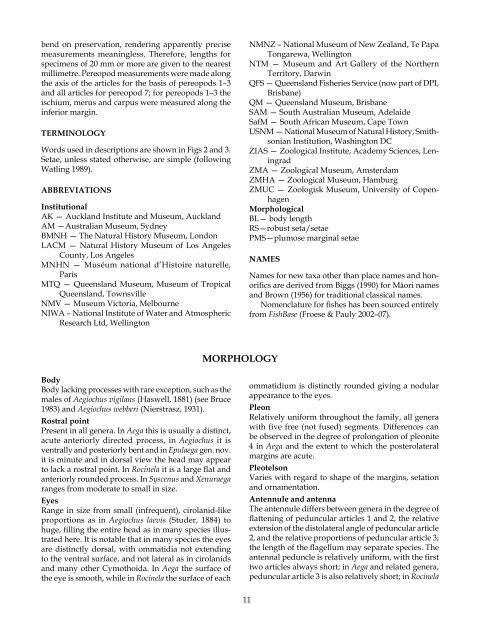The Marine Fauna of New Zealand: Isopoda, Aegidae (Crustacea)
The Marine Fauna of New Zealand: Isopoda, Aegidae (Crustacea)
The Marine Fauna of New Zealand: Isopoda, Aegidae (Crustacea)
You also want an ePaper? Increase the reach of your titles
YUMPU automatically turns print PDFs into web optimized ePapers that Google loves.
end on preservation, rendering apparently precise<br />
measurements meaningless. <strong>The</strong>refore, lengths for<br />
specimens <strong>of</strong> 20 mm or more are given to the nearest<br />
millimetre. Pereopod measurements were made along<br />
the axis <strong>of</strong> the articles for the basis <strong>of</strong> pereopods –3<br />
and all articles for pereopod 7; for pereopods –3 the<br />
ischium, merus and carpus were measured along the<br />
inferior margin.<br />
tErmINOlOgy<br />
Words used in descriptions are shown in Figs 2 and 3.<br />
Setae, unless stated otherwise, are simple (following<br />
Watling 989).<br />
AbbrEvIAtIONs<br />
Institutional<br />
AK — Auckland Institute and Museum, Auckland<br />
AM —Australian Museum, Sydney<br />
BMNH — <strong>The</strong> Natural History Museum, London<br />
LACM — Natural History Museum <strong>of</strong> Los Angeles<br />
County, Los Angeles<br />
MNHN — Muséum national d’Histoire naturelle,<br />
Paris<br />
MTQ — Queensland Museum, Museum <strong>of</strong> Tropical<br />
Queensland, Townsville<br />
NMV — Museum Victoria, Melbourne<br />
NIWA – National Institute <strong>of</strong> Water and Atmospheric<br />
Research Ltd, Wellington<br />
body<br />
Body lacking processes with rare exception, such as the<br />
males <strong>of</strong> Aegiochus vigilans (Haswell, 88 ) (see Bruce<br />
983) and Aegiochus webberi (Nierstrasz, 93 ).<br />
rostral point<br />
Present in all genera. In Aega this is usually a distinct,<br />
acute anteriorly directed process, in Aegiochus it is<br />
ventrally and posteriorly bent and in Epulaega gen. nov.<br />
it is minute and in dorsal view the head may appear<br />
to lack a rostral point. In Rocinela it is a large flat and<br />
anteriorly rounded process. In Syscenus and Xenuraega<br />
ranges from moderate to small in size.<br />
Eyes<br />
Range in size from small (infrequent), cirolanid-like<br />
proportions as in Aegiochus laevis (Studer, 884) to<br />
huge, filling the entire head as in many species illustrated<br />
here. It is notable that in many species the eyes<br />
are distinctly dorsal, with ommatidia not extending<br />
to the ventral surface, and not lateral as in cirolanids<br />
and many other Cymothoida. In Aega the surface <strong>of</strong><br />
the eye is smooth, while in Rocinela the surface <strong>of</strong> each<br />
NMNZ – National Museum <strong>of</strong> <strong>New</strong> <strong>Zealand</strong>, Te Papa<br />
Tongarewa, Wellington<br />
NTM — Museum and Art Gallery <strong>of</strong> the Northern<br />
Territory, Darwin<br />
QFS — Queensland Fisheries Service (now part <strong>of</strong> DPI,<br />
Brisbane)<br />
QM — Queensland Museum, Brisbane<br />
SAM — South Australian Museum, Adelaide<br />
SafM — South African Museum, Cape Town<br />
USNM — National Museum <strong>of</strong> Natural History, Smithsonian<br />
Institution, Washington DC<br />
ZIAS — Zoological Institute, Academy Sciences, Leningrad<br />
ZMA — Zoological Museum, Amsterdam<br />
ZMHA — Zoological Museum, Hamburg<br />
ZMUC — Zoologisk Museum, University <strong>of</strong> Copenhagen<br />
morphological<br />
BL— body length<br />
RS—robust seta/setae<br />
PMS—plumose marginal setae<br />
NAmEs<br />
mOrphOlOgy<br />
Names for new taxa other than place names and honorifics<br />
are derived from Biggs (1990) for Mäori names<br />
and Brown ( 956) for traditional classical names.<br />
Nomenclature for fishes has been sourced entirely<br />
from FishBase (Froese & Pauly 2002–07).<br />
ommatidium is distinctly rounded giving a nodular<br />
appearance to the eyes.<br />
pleon<br />
Relatively uniform throughout the family, all genera<br />
with five free (not fused) segments. Differences can<br />
be observed in the degree <strong>of</strong> prolongation <strong>of</strong> pleonite<br />
4 in Aega and the extent to which the posterolateral<br />
margins are acute.<br />
pleotelson<br />
Varies with regard to shape <strong>of</strong> the margins, setation<br />
and ornamentation.<br />
Antennule and antenna<br />
<strong>The</strong> antennule differs between genera in the degree <strong>of</strong><br />
flattening <strong>of</strong> peduncular articles 1 and 2, the relative<br />
extension <strong>of</strong> the distolateral angle <strong>of</strong> peduncular article<br />
2, and the relative proportions <strong>of</strong> peduncular article 3;<br />
the length <strong>of</strong> the flagellum may separate species. <strong>The</strong><br />
antennal peduncle is relatively uniform, with the first<br />
two articles always short; in Aega and related genera,<br />
peduncular article 3 is also relatively short; in Rocinela

















